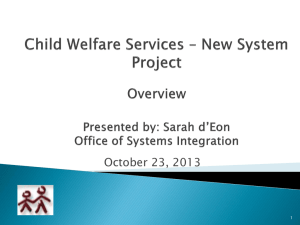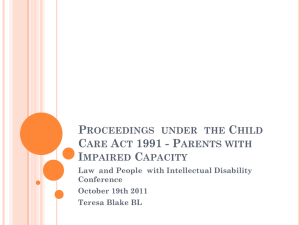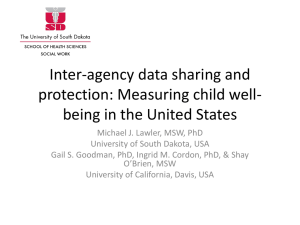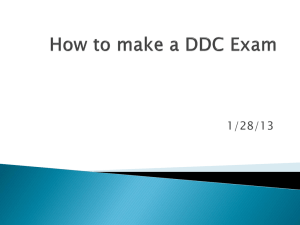Uses of Data by the National Center on Substance Abuse and Child
advertisement
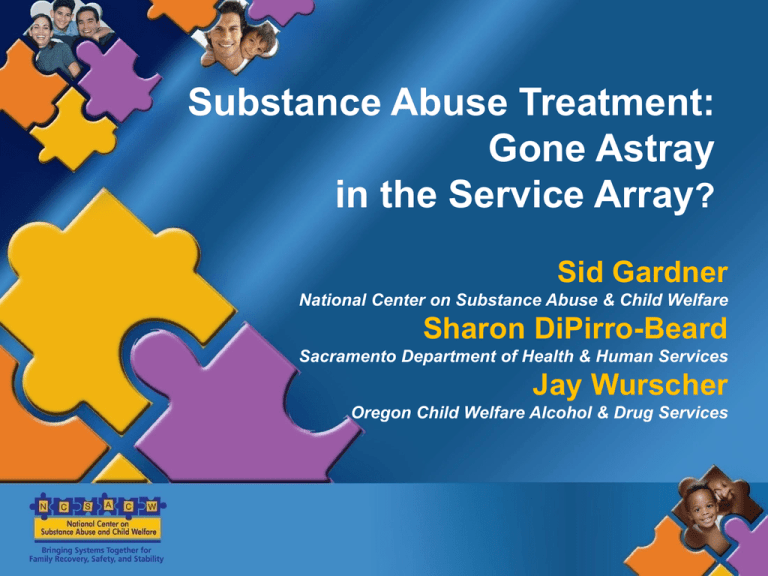
Substance Abuse Treatment: Gone Astray in the Service Array? Sid Gardner National Center on Substance Abuse & Child Welfare Sharon DiPirro-Beard Sacramento Department of Health & Human Services Jay Wurscher Oregon Child Welfare Alcohol & Drug Services A Program of the Substance Abuse and Mental Health Services Administration Center for Substance Abuse Treatment and the Administration on Children, Youth and Families Children’s Bureau Office on Child Abuse and Neglect TEXT PAGE Agenda • • • • Welcome and Introductions Use of Data at the Policy Level Substance Abuse in CSFR State Baseline Example: Options for Data Analysis and Policy Choices Using Existing Data Sources • Case Study: Sacramento County Dependency Drug Court • Case Study: Oregon Child Welfare Alcohol & Drug Services • Discussion TEXT PAGE Uses of Data at the Policy Level • Using cross-cutting, interagency data is often more challenging and more useful than single-agency data sets • For example, drug/alcohol treatment capacity can be compared with child welfare treatment demand/referrals – (in response to the widespread perception that “there are no treatment slots, so why record the need?”) – In virtually every case, treatment availability numbers are 2-3 times greater than child welfare demand or estimated need Substance Abuse in the Children & Family Services Review (CFSR) The CFSR Service Array and Substance Abuse • 28 of 30 states referenced substance abuse in their assessments • 16 of 16 PIPS referenced substance abuse issues • But states’ prevalence numbers in CFSR case reviews were far lower than states’ own estimates of need • And states’ AFCARS data on substance abuse range widely, from 4% up to 66% of foster care caseloads What’s in YOUR self-assessment for CFSR? • CAPTA numbers? – Confirmed prenatal exposure referrals to CPS? – Referrals of 0-2 year olds for developmental assessments—and what services they received? • An estimate of the treatment gap for parents with child welfare cases? • A comparison of AFCARS % with other states? All of these are available from federal data items—but most are not reported annually The missing numbers • • • • CAPTA data listed above The treatment gap and/or reunification gap Total CW clients now entering treatment Progress made by CW clients in treatment: positive outcomes, dropouts • % of women entering treatment compared with other states (a partial proxy for CW clients) • % of 0-1 year olds entering foster care Use of Data from CFSR Assessments and Plans • At state and local levels, CFSR outcome gaps can be compared with treatment availability—how many more successful treatment completions would move the needle toward meeting CFSR goals? • In three counties, the treatment slots needed to impact CFSR targets was only 1-2% of treatment resources already available in the county • This reframes the discussion of the “treatment gap” to a discussion of policy priorities for child welfare families and two-generation, family-centered treatment, as adopted in policy changes in Arizona and Sacramento County CFSR Data and AFCARS Data on Substance Abuse Impact • Using data from these two sets of information about the prevalence of substance abuse shows a wide variation among states—and a low overall capture rate of data on the problem Parental Substance Use Cited as Factor in Child Welfare Case Parental or Alcohol Drug Abuse as Substance Abuse as Primary Reason for Case Opening Factor in Cases of Child Removal 2007 AFCARS Data Parental Alcohol or Drug Abuse as Factor in Cases of Child Removal (N=190,900 Cases) State A B C D** E F G H I J** Percent 4.4 5.8 9.2 10.0 11.8 42.6 46.4 51.0 58.0 63.6 CFSR Round 1 Review 2001-2004 (N=50 Cases) CFSR Round 2 Review 2007-2010 (N=65 Cases) Percent 16 Percent 20 16 2 4 2 18 8 8 TEXT PAGE States. *In Round 1, these data were not included in the first cohorts of States reviewed, it was an added item in subsequent 8 14 31 8 27 State Baseline Example: Options for Data Analysis and Policy Choices Using Existing Data Sources The purpose of analysis • To refine estimates of the total treatment need among parents from the child welfare system (and others who may be at risk of entering the CW system) • To clarify assumptions about need, engagement, and system capacity • To specify a range of proven need, from data documented in state agency records and estimates based on other data sources The ingredients of analysis • • • • CFSR goals CWS/CMS data on substance abuse need CalOMS analysis of CW/DDC client outcomes Assumptions about client retention and final treatment outcomes • Conversion of case counts to children and parent counts Starting point analysis Starting Point Number needing treatment [converted to parents] CWS cases with SA treatment in plan 28,051 CWS foster care population (62,528) If need =27.8%= If need = 67%= (28,436 entries 08-09) 45,020 Treatment clients referred from CW/DDCs CFSR reunification gap Entered treatment Positive treatment completions 12,516 30,163 6,998 5,558 TEXT PAGE 2,525 What Does CWS Say? Substance Abuse (SA) Documentation in CWS by Year 2005 - 2008 40,000 '05 '06 35,000 '07 '05 '08 Count Once per Case 30,000 '06 '07 '08 25,000 '05 20,000 '06 '07 '08 15,000 10,000 5,000 '06 '07 '05 '06 '07 '08 '08 '05 '05 '06 '07 '08 0 '05 '06 '07 '08 SA Case Plan Planned Service Activity SA Service Contact Type SA Client Condition Type (Minors Only) 31,680 19,454 2,084 3,643 34,620 30,797 20,380 5,756 3,890 5,721 33,602 31,089 21,076 5,779 3,871 4,884 29,940 28,051 20,007 4,809 3,416 SA Case Intervention Reason SA Secondary Removal Reason SA Case Plan SA Case Plan Service Contributing Factor Objective '05 1,940 5,616 36,306 '06 1,560 5,728 '07 1,286 '08 1,040 TEXT PAGE What Does Treatment Say? • Of 166,441 unique clients entering treatment in 2008, – 6,998 were identified as referred from CW or DDC sources – Of these referred clients, 36.1% (2,525) achieved positive outcomes in treatment – This compares with all other clients who achieved 35.1% positive outcomes Specifics of the Formula • Total caseload: 101,025 open cases • x 27.8% whose case plan mentioned SA in case plan service objectives = 28,051 • x 50% who will enroll once referred to treatment = 14,025 • x 36.1% who will complete treatment with positive outcomes (CalOMS rate)= 5,063 Dropoff Points 1,000 Children – 720 Parents in Substantiated Cases 27.8% of Parents Need SA treatment 200 50% Enroll in treatment 100 36.1% Achieve Positive Treatment Outcomes 36 Actual Reunifications Payoff TEXT PAGE 19 Dropoff Points 97,507 Children= 70,205 Parents in Substantiated Cases 27.8% of Parents Need SA treatment 19,517 50% Enroll in treatment 9,758 36.1% Achieve Positive Treatment Outcomes 3,523 Actual Reunifications ? Payoff TEXT PAGE 20 System-wide Improvements • At least 4,500 CWS parents are already entering treatment • To increase positive completions requires – Better identification of need through screening and assessment – Better client engagement and retention practices – Improved treatment quality to meet the specific needs of families from the child welfare system The reunification gap • Current rate 12-month reunifications : 62.4%= 11,537/18,484 • National target: 75.2% (13,900) • Gap between current and target level: 2,363 • Child-parent ratio conversion: .72= 1,701 parents • Eliminating the reunification gap through treatment completions requires additional 4,725 treatment entries • That level of new admissions = 2.4% of total treatment admissions [assuming no overlap, which is obviously significant, with 7,000 CW entries documented 2008] Resources • “Connecting the Dots: How States and Counties Have Used Existing Data Systems to Create Cross System Data Linkages” Webinar http://www.cffutures.org/webinars/connecting-dots-howstates-and-counties-have-used-existing-data-systemscreate-cross-system • Schuerman, J.R., Needell, B. (2009). The Child and Family Services Review Composite Scores: Accountability off the Track. Chapin Hall at the University of Chicago. • Child and Family Futures Data Dictionary Case Study: Sacramento County Dependency Drug Court Presented by: Sharon DiPirro-Beard Program Context • Sacramento County population: 1.5 million • Between Oct 07 and Sept 08 there were 2118 child abuse/neglect intake petitions filed • An estimated 70 to 80% of child welfare cases involve families affected by substance use Sacramento County’s Comprehensive Reform Six Components of Reform 1. 2. 3. 4. 5. 6. Comprehensive Cross-System Joint Training Substance Abuse Treatment System of Care Early Intervention Specialists Recovery Management Specialists (STARS) Dependency Drug Court Early Intervention Drug Court (EIFDC) Sacramento County Prior to STARS and Dependency Drug Court • 36 Month Reunification rate at 26.0% • Parents unable to access substance abuse treatment • Social workers, attorneys, courts often uninformed on parent progress • Drug testing not uniform and results often delayed Sacramento County after STARS and Dependency Drug Court • 36 Month Reunification Rates 45.7% • Reunification is occurring faster • Parents truly have “treatment on demand” • All parties involved in the case are informed at every stage of treatment • All parents receive random observed “instant” drug testing Data Sources and Tracking CWS clients in Treatment Data Sources • Measured outcomes are arrived at through the culmination of data from: – Preliminary Assessments – California Outcomes Measurement System (CalOMS; the CA version of NOMS) – Child Welfare Services/Case Management System (CWS/CMS; SACWIS in other States) – Home Court and Dependency Drug Court – STARS Intake and Twice Monthly reports 30 31 Matching Records • From the 19 digit CWS/CMS identifier a 10 digit identifier for parents is automatically generated through an extract run from CWS/CMS, which creates a text file that is sent to ADS • The Drug Court Coordinator matches the 10 digit identifiers with parents that have appeared for STARS and DDC services. – If any identifiers cannot be matched, the identifiers are sent back to STARS for more information Matching Records • At intake, STARS creates a 10 digit Unique Participant ID for parents receiving STARS/DDC services – This 10 digit identifier is the same format of what would be entered in CalOMS and generated by CWS/CMS • ADS matches the 10 digit ID from CMS/CMS with the STARS/DDC database on the parents 32 Matching Records • Use of CalWORKs (TANF) Funds – Clients receiving STARS services can be claimed through CalWORKs substance abuse treatment funding – STARS client list is sent to Department of Human Assistance to identify individuals with open CalWORKs cases. Matched cases are sent back to CPS to claim a percentage. – CalWORKs allows for clients to receive services even if children are not in their parent’s care. • DHA must be notified within 30 days that children have been removed. If children are removed, and the parent is still receiving treatment services, DHA will keep the CalWORKs case open for 6 months. Otherwise, the case will be closed. – A CalWORKs works with CPS to integrate CalWORKs for their clients. A CalWORKs coordinator is now located at the STARS site. If CalWORKs has been terminated, the coordinator may be able to reinstate services 34 Data Extraction • The 10 digit Parent Identifier is matched to CalOMS Unique Participant ID to extract treatment data • Treatment data is only extracted for a cohort of data. CFF Evaluator sends a “cohort” list to ADS, plus alternate IDs for aliases. ADS imports data into an Excel database and sends data to the CFF Evaluator. • CWS/CMS Special Projects page, Project Start Date is used to extract and send placement reports to CFF for children whose parents entered DDC/STARS Analyses • The CCF contracted Evaluator combines treatment data, STARS intake and twice-monthly report data, and child placement data into an Excel database for SPSS analyses 35 36 Confidentiality • Release of information names all agencies involved in the DDC/STARS team – County Council reviewed and approved the form • Data utilizes Unique Identifiers, and does not include identifying information (e.g. names) • Data shared and transmitted for evaluation is encrypted and password protected Evaluation Findings PARENTS AND CHILDREN IN THE EVALUATION 1000 900 800 700 600 500 400 300 200 100 0 36 Mos 36 Mos 36 Mos 36 Mos 36 Mos 741 36 Mos 12 Mos 731 605 432 324 485 428 249 274 CO YR2 CO YR3 448 489 442 400 305 173 111 Comparison CO YR1 Parents Comp Parents = 111 DDC Parents = 2,442 CO YR4 CO YR5 CO YR6 CO YR7 Children Children = 173 Children = 3,911 Source: CWS/CMS TREATMENT OUTCOMES: TIME IN TREATMENT 300 293.2 250 200.2 Days 200 150 114.5 100 83.9 50 0 Total Time in Treatment** Comparison * p<.05; **p<.01 Days Per Treatment Episode* Court Ordered Comp n=111; DDC n=2422 Source: CalOMS TREATMENT OUTCOMES: DISCHARGE STATUS differences not significant Comp n=111; DDC n=2422 Source: CalOMS 36 MONTH CHILD PLACEMENT OUTCOMES 100 80 Percent 60 45.7 40 33.5 26.0 26.7 20 12.7 17.3 7.3 5.1 1.7 1.9 8.7 13.5 0 Reunification*** Adoption Guardianship** Comparison **p<.01; ***p<.001 FR Services Long-Term Placement*** Other Court-Ordered Comp n=173; DDC n=2086 Source: CWS/CMS RE-ENTRY TO FOSTER CARE RATES Comp n=173; DDC n=2086 Source: CFSR, CWS/CMS 24 MONTH COST SAVINGS DUE TO INCREASED REUNIFICATION What would have happened regarding out of home care costs in the absence of DDC? 27.2% - Reunification rate for comparison children 48.6% - Reunification rate for DDC children = 603 fewer DDC children would have reunified 33.1 - Average months in out-of-home care for comparison children 9.02 - Average months to reunification for DDC children = 24.08 months that DDC kids would have spent in out of home care (OHC) $1,849.16 – Out of home care cost per month 603x 23.88 x 1849.16 = $26,850,247 Total Savings in OHC Costs Case Study: Oregon Child Welfare Alcohol & Drug Services Presented By: Jay Wurscher Intensive Treatment Recovery Services (ITRS) • How are child welfare/treatment data and outcomes connected to the State level assessment of need for substance abuse treatment and capacity to serve child welfare clients? • How are child welfare/treatment data and outcomes connected to the State level CFSR process (the CFSR Final Report or the Program Improvement Plan)? • How is this data being used in conversations between the state level treatment and child welfare agencies? ITRS Key Findings • Drug and alcohol treatment for the parents of foster children plays a critical role in determining when a child can safely return home. • Over 40 percent of children whose parents are or were involved in treatment have achieved physical reunification. • For children who have reunified, children of ITRS-served parents have a shorter length of stay in foster care compared to the prior biennium’s group of foster children whose parents received AMH treatment services. Discussion
